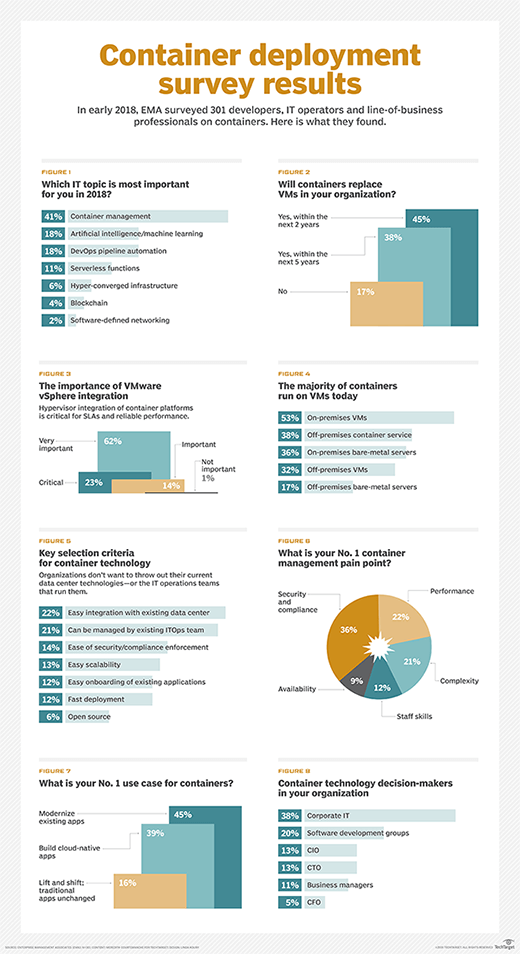Ten lessons for enterprises deploying containers
The majority of medium to large enterprises surveyed by EMA foresee containers replacing VMs in two to five years. Unsurprisingly, container management and shadow containers are pressing concerns.
Containers are an IT trend full of high expectations and operations concerns.
Containers promise to enable applications to float through the data center and cloud, managed by DevOps teams, without much need for costly IT operations management anymore. But enough technologies have come and gone to keep an industry analyst attuned to the fact that someone deploying containers has to guarantee service-level agreements and ensure security, performance, data locality, availability and scalability.
When they engage in the container discussion and shape a strategy, enterprises should absorb these 10 lessons. The lessons result from a two-month-long research project, the Enterprise Management Associates (EMA) Top 3 Decision Guide. EMA surveyed developers, IT operations and line-of-business staff from 300 U.S.-based enterprises, having 500 or more employees.
1. Container management trumps AI, DevOps in enterprises
Container management is the most important IT topic of 2018, far ahead of AI, DevOps pipeline automation and serverless, according to survey respondents. However, the same respondents predicted AI will become the most important topic in 2019.
2. Containers are no magic potion
There's plenty of enthusiasm -- even hype -- over containers, with 83% of respondents indicating that containers will replace VMs entirely within five years and 45% of that group believing that this will happen on an accelerated timeline, within 24 months. However, these same study respondents identified a plethora of challenges with deploying containers that often destroy the business case for it. To attain success with containers, organizations must attack these challenges and learn in the process.
3. Rein in shadow containers
Container deployments not controlled by corporate IT -- so-called shadow containers -- affect 72% of enterprises, according to the survey. Shadow containers and shadow Kubernetes result from several factors. Containers are often not seen as infrastructure and instead as part of an application; business units make the argument that IT operations only needs to provide the infrastructure, while developers manage container platforms. Shadow containers stand in the way of corporate IT's ability to ensure service-level agreements (SLAs) and provide support when things go wrong. Therefore, the interface between containers and the hypervisor is the critical integration point between containers and corporate IT.

4. Containers need VMs -- for now
Half of EMA's survey respondents run containers on on-premises VMs, while 32% run on off-premises VMs, adding up to a large majority (85%) that rely on the more conventional abstraction technology. This is the case due to container schedulers, such as Kubernetes and Docker swarm mode, not being infrastructure-aware. The deployment, therefore, needs a solid management foundation for compute, storage and networking, provided by conventional virtualization.
5. Container technology is all about integration
Integration with current data center technologies is the No. 1 requirement for enterprises selecting container technologies. Enterprises struggle to enable their current IT operations staff to control security, compliance, availability and performance across bare metal, hypervisors, containers and various other platforms in use.
6. Security and compliance complicate container adoption
Security and compliance are the No. 1 container management pain points, significantly ahead of performance, complexity of container deployment and reskilling staff for the technology. Half of respondents have no solid compliance plan in place, and 58% do not include policy staff in their ongoing DevOps and container management projects and tasks.
7. Apps don't stay the same in containerization
Only 16% of enterprises are primarily deploying applications in containers with a lift-and-shift approach. Modification to the application is paired with containerization for 45% of respondents. Behind application modernization, 39% of respondents regard building new cloud-native applications as their key use case.
8. IT operations calls the shots
Corporate IT is the most influential group when it comes to container technology decisions, with software development groups in second place.
Nearly 40% of survey respondents said that corporate IT should make the decisions around deploying containers, while only 20% assigned that role to the software developers.
Container decisions come from the ground up, the survey indicated, with the CIO, CTO and CFO falling behind IT and developers.
9. Containers as a service are popular
Amazon Elastic Container Service, Google Kubernetes Engine, Microsoft Azure Container Service and IBM Cloud Container Service are in a close race to host the most container workloads. Enterprises must understand how and when to integrate these containers-as-a-service offerings with traditional and containerized applications that run in the data center today.
10. Kubernetes doesn't stand alone
Kubernetes is an open source container orchestration and scheduling tool and the basis of a wide array of commercial container management products. Ninety percent of enterprises surveyed indicated that they require a commercial container management solution to effectively manage Kubernetes, with 96% reporting that they use external professional services to manage the container lifecycle.






